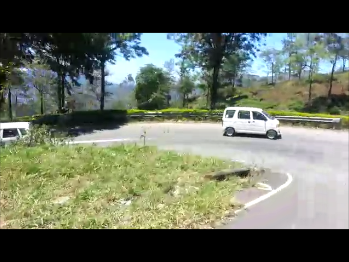By train
from Ella to Nuwara Eliya
This is said to be one of the most scenic and
beautiful railway journeys in the world, a 4-hour climb from Ella at 6,000 ft,
through the mountains and tea plantations to Nuwara Eliya at 7,500ft.
A wonderful
route took us across ravines and
streams, though tunnels, past
waterfalls, around precipitous drops and all the while overlooked by 'Pidurutalagala', the
highest mountain in Sri Lanka.
Incident en-route
The train
came to a sudden halt on a bend, spilling my coffee that the attendant had just
brought from the galley.
Looking
out, we saw that our big diesel engine had separated from the carriages and was
disappearing ahead, leaving us behind. Fortunately, our alert Guard pulled the
emergency brake and prevented us running out-of-control back downhill!
Before
long, our engine returned and we all jumped out onto the track to offer helpful
advise about a re-connection. This took some time as arguments passes back and
forth. Finally an engineer with a large hammer bashed the errant coupling into
place.
We all
applauded this very fine piece of work and everyone climbed back aboard, happy and smiling as the train restarted -
just as if nothing had happened. What a wonderful country!
A potted history
The first
tea plantations on the island were established in the 'Hill Station' of Nuwara
Eliya in the early 1800's by two Scottish migrants, James Taylor and Thomas Lipton. Others quickly followed and tea cultivation
became a major industry. Bulk delivery of the crop was made possible by
constructing a narrow gauge railway up into the mountains and down to the coast.
The
scorching heat at sea level encouraged the British to use the railway to
relocate their families into the cooler temperatures of the mountains, where
they built grand houses complete with gardens, red brick walls and wrought iron
fencing.
The 'hill station' grew into a
town that became known as ‘Little England’ with an artificial lake, two
Scottish churches, a huge Catholic Church, a St Andrews Golf Club, a Grand
Hotel, a Windsor Hotel and two landscaped roads: Lady McCullum Drive and Lady
Horton Road.
In addition the Royal
Botanical Garden was established to discover improved tea hybrids and Galway
Forest Reserve was setup to prevent over- building in the mountains surrounding
the town.
Much of that old colonial influence still exists today alongside new development. We rented an apartment
in this modern block, a short walk from town centre.
The Royal Botanical gardens were in full bloom when we visited.
Our hotel was a modern block just a few minutes walk uphill and overlooking the town
The view from
our balcony was very commercial. In the foreground a small factory making towels and then a jumble of narrow streets with housing, shops and businesses, but a really interesting place for walks around town.

Horsing around
Animals
wander all around town. Several horses used to visit every morning and
enjoyed rolling in a large pile of sand
opposite our apartment.
Oops! some left calling cards just inside the hotel gates !
Grand Hotel
Beautifully
maintained, preserving original furniture, lighting, pictures and
ambiance. We enjoyed several evenings
here with drinks before dinner relaxing in deep leather armchairs beside
blazing log fires.
St Andrews Hotel
Well managed by the
Jetwing Group and reminiscent of a hotel in the Highlands of Scotland. We
didn't play, but the golf course looked challenging
The golf course was well manicured but we saw no golfers on the day of our visit
The hotel gardens were full of flowers, shrubs and amazing topiary.
The Prime Minister was not at home so we had no invitation for tea.
A walk around town
Let’s go to the flicks. The facade of the old Regal Cinema, a sad and neglected relic from a bygone era when perhaps, people swarmed in to see the latest Charlie Chaplin movie. It’s entrance doors are wide open and it now seems to be a safe haven for the stray dogs.
Streets were always busy.
William stopped to look at a box of baby chicks which had been left by a lamp post - hopefully someone was coming back to collect them!
We had a good supermarket in town
For all of you with three wheelers this is the place to buy tyres!
We stayed two weeks in Nuwara Eliya.
-













































